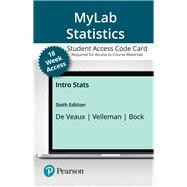For courses in Introductory Statistics.
This ISBN is for the 18-week MyLab access card. Pearson eText is included.
Innovative methods, technology, and humor encourage statistical thinking
Intro Stats, 6th Edition by De Veaux/Velleman/Bock uses inventive strategies to help students think critically about data, while maintaining the book's core concepts, coverage, and readability. By using technology and simulations to demonstrate variability at critical points throughout the course, the authors make it easier for instructors to teach and for students to understand more complicated statistical concepts later in the course.
This revision includes several enhancements, enriching material with greater use of the authors' signature tools for teaching about randomness, sampling distribution models, and inference. Current discussions of ethical issues have been added throughout, and each chapter now ends with a student project that can be used for collaborative work.
Personalize learning with MyLab Statistics with Pearson eText
This flexible digital platform combines unrivaled content, online assessments, and customizable features to personalize learning and improve results.
Pearson eText is an easy-to-use digital textbook available within MyLab that lets you read, highlight, and take notes all in one place.
NOTE: Before purchasing, check with your instructor to confirm the correct ISBN. Several versions of the MyLab® and Mastering® platforms exist for each title, and registrations are not transferable. To register for and use MyLab or Mastering, you may also need a Course ID, which your instructor will provide.
Used books, rentals, and purchases made outside of Pearson
If purchasing or renting from companies other than Pearson, the access codes for the MyLab platform may not be included, may be incorrect, or may be previously redeemed. Check with the seller before completing your purchase











